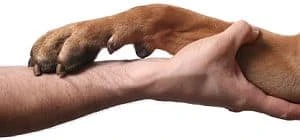Canine Nail Fungus: A guide to this health problem
A Guide to Canine Nail Fungus…

Canine nail fungus is actually more common in male dogs than females and is sometimes seen in dogs that lead an active life style i.e. working dogs – the reason for this is because these types of dogs spend large amounts of their time in rivers, streams and creaks where the microorganism normally resides (in moist dark places like decaying trees, soil and dead plants). The name of the microorganism that causes this infection is called Blastomyces Dematitidis.
This microorganism relishes conditions that have very low Ph levels and if your pooch does develop the condition it can lead to some unpleasant symptoms.
The Causes of Nail Fungus in Dogs – As previously mentioned the main cause of canine nail fungus is a microorganism called Blastomyces Dermatitidis. This Microorganism lives in damp conditions where the PH level is low – so it can be found in wet and damp areas such as rivers, streams and creaks. After the fungal infection takes hold it may cause the following symptoms…
Canine Nail Fungus – Symptoms – Your dog will probably have severe itching and will attempt to get at the itch. This may involve your dog licking, pawing or biting his nails to alleviate the itch.It is also possible that a dog with nail fungus does not show any symptoms at all and acts and behaves perfectly normal however the nails might be slightly discolored and fracture and break easily.
Canine Nail Fungus – Diagnosis – The diagnosis of this health condition is relatively easy. A vet will normally take a small biopsy from the area affected which will then be examined under a Microscope for presence of the fungal infection.
Treatment & Prevention – The conventional treatment for this condition will normally involve a Vet prescribing a topical creme that is applied to the affected area. The Vet may prescribe a spray as opposed to a creme but both treatments will have anti-fungal properties. The only problem with this is that the dog will often lick or attempt to get rid of the creme. To prevent this it is not uncommon for a dog to have to wear the conical cone that is placed around the neck.
Home Remedies – Some owners use a mixture of apple cider and water dabbed on the affected area. Vinegar does not taste particularly appetizing to dogs and it will not only stop your dog constantly licking the affected area but as you probably know vinegar has amazing antiseptic properties and is fantastic at killing germs and any fungal infections. Apple Cider Vinegar and water is also sometimes used to wash the paw after the dog has come in from outside and if a fungal infection has started (this can stop any fungal infection from developing).
If you take your dog for a walk regularly make sure you avoid any areas that are particularly damp or wet and look like they might be a breeding ground for the main cause of the condition i.e. Blastomyces Dermatitidis. If you do take your dog for long walks in damp areas make sure you give your dog a good wash when he gets back (make sure you dry all the areas thoroughly too).
Wash and bath your dog regularly as this will keep your dog clean and help to wash off any dirt or water that might be housing the Blastomyces Dermatitidis microorganism.
Feed your dog a good and well balanced diet as this will help to keep you dog’s immune system strong and more able to fight off any infection.
Useful Links:
www.dog-health-problems-online.com – a useful site with more information on the condition.
More conditions that affect a dog’s toenails…
Although nail fungus affects the toenails (paw nails) there are other conditions that can affect a dogs nails – we have listed some of the more common problems below.
1. One of the most common problems that affect a dog’s nails is a problem that also affects human (over grown toenails). Unfortunately dogs are not able to cut or trim their nails which can cause problems. Of course some dogs spend much of their time working whether this is herding Sheep or on a Shoot – this constant and recurrent exercise will help to wear the nails down so they may not have to be cut or trimmed so often. A common problem for a dog that does not have his nails cut is for them to get broken. Of course this can leave an area exposed for possible bacteria to enter and cause infection.
2. Another relatively common problem is when a dog’s toenails crack – this is normally due to problems around the immune system. Another cause of cracked toenails is due to a poor diet where a dog is not getting the right amount of vitamins and minerals. Diet is so important for a dog’s overall health – if you have any doubts always check with your vet as they can give you information on finding the right nutritional balance for your pooch.
3. A torn nail is one of the most painful conditions affecting dogs. This is often caused when a dog has caught his toe and then the nail on a stray carpet thread or anything that has caused the ‘Quick’ to be exposed. The ‘Quick’ is the tissue that is found underneath the hard nail outer coating. This is where all of the nerves (and nerve endings) and blood vessels reside. If your dog has a black nail then it is more difficult to tell whether the ‘Quick’ as been exposed – if it has it will cause your dog severe pain and discomfort.
4. Bacterial and fungal infections are also a problem with some dogs – if an infection does occur it can leave your dog in some pain and may cause problems when walking or putting weight on the paw.





